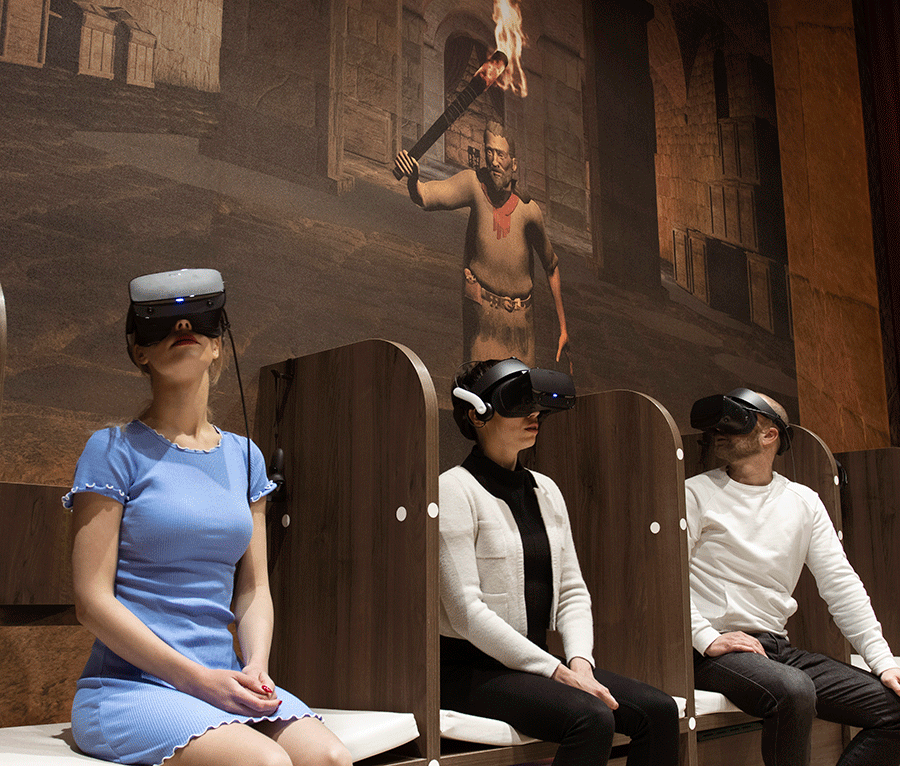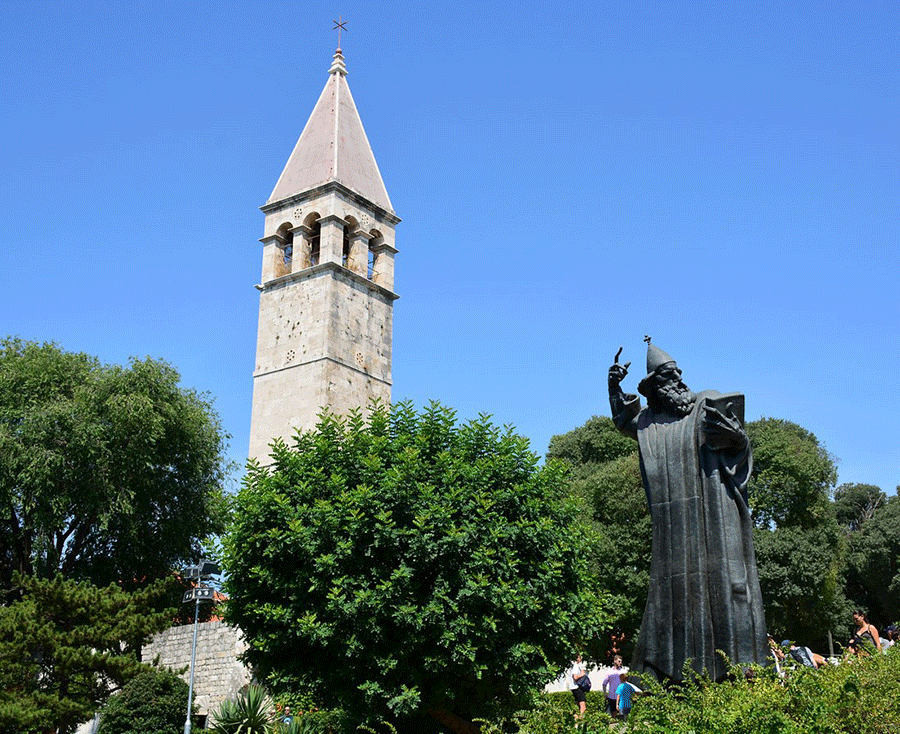The bustling port city of Split on Croatia’s Dalmatian Coast is one of the jewels in the Adriatic crown, affording visitors a myriad of unique ways to occupy their time.

A view over the rooftops in Split’s Old Town (Photo: Nikolaj Potanin via Flickr / CC BY-SA 2.0)
Dotted with cafes, restaurants and galleries, Split’s rich history and bustling atmosphere make it one of the country’s most popular tourist destinations, with many using it as a base from which to explore the numerous idyllic islands located off this stretch of the Croatian coastline. If you’re planning a trip to Split and would like to start filling your itinerary with some unique things to see and do, we’ve picked out 12 of the best.
Take a wander around Old Split
A historical and cultural goldmine, Split’s Old Town dates back 1,700 years and is home to some of the most impressive ancient ruins in the world. Among the most visited is the Diocletian’s Palace, an extraordinary complex spread across almost half of the Old Town district. Built for the Roman emperor Diocletian at the turn of the fourth century AD, the palace was declared a UNESCO World Heritage Site in 1979 and is widely considered one of the most imposing ancient Roman structures in existence. Other Old Town attractions include colourful local markets and a picturesque harbour.
Marjan Park
For an escape from the hustle and bustle of the city, the beautiful Marjan Forest Park offers the perfect antidote. Situated in Split’s western fringes, the vast nature reserve is a veritable green oasis, with numerous trails passing through fragrant pine forests to scenic lookouts, a 16th-century Jewish cemetery, medieval chapels and cave dwellings once inhabited by Christian hermits. Nearby cliffs also make the park a popular spot with climbers. The park is free to enter.
Obala Hrvatskog narodnog preporoda 25

The verdant greenery of Marjan Forest Park (Photo: bmw3528 via Flickr / CC BY 2.0)
Walk around a medieval fortress
There are few ancient castles or ruins in this world where visitors are free to wander around the grounds unencumbered by ropes or locked doors – but Klis Fortress is one of them. Overlooking Split in the hillside village of Klis, the 2,000-year-old medieval fortress is built into a rocky ridge that affords a stunning bird’s-eye view of the city, the Adriatic Sea and surrounding islands. The seat of many Croatian kings down the ages, the castle played a pivotal role in Split’s defence against the Ottoman invasion during the 16th century, adding to its allure as a modern-day tourist attraction.
Trg Mejdan 10

The ancient ruins of Klis Fortress (Photo: Sergei Gussev via Flickr / CC BY 2.0)
Visit the world’s oldest cathedral
Originally built as the mausoleum of the legendary Roman Emperor Diocletian, the central portion of the grand old St. Duje’s Cathedral dates all the way back to 350, affording it the prestigious title of the oldest cathedral in the world. Fascinating remnants from its Roman past, including the original ring of 24 supporting columns, still stand, while the cathedral’s romanesque wooden doors, have survived unchanged since 1200. A ticket for the cathedral includes admission to its eerily quiet crypt, as well as its treasury and baptistery.
Ul. Kraj Svetog Duje 5, Peristil / Mon-Sat 8am-7pm; Sun 12.30pm-6.30pm
Explore a museum
Founded in the 2nd or 3rd century BC, the city of Split is a historical goldmine. But while many of its ancient relics remain in situ, some 20,000 of them have been moved to the comfort of the magnificent Museum of Croatian Archaeological Monuments. Most of the pieces on display here date back to medieval times and include such esoteric items as include jewellery, weapons, armour and everyday household accessories. Among the highlights are an assortment of stone inscriptions, reliefs and carvings relating to the Croatian kings, nobility and clergy from the 800s to the 1100s.
Gunjačina ul. bb / Mon-Fri 9am-8pm Sat 9am-2pm Closed Sun

Inside the Museum of Croatian Archaeological Monuments (Photo: Museum of Croatian Archaeological Monuments))
The Homeland War Museum is a specialised historical museum that explores the Homeland War, an event of historical importance for the Republic of Croatia. The war was fought from 1991 to 1995 after Croatia had declared independence from the Socialist Federal Republic of Yugoslavia and the Serb-controlled Yugoslav People’s Army. The museum collections include military equipment, weapons, uniforms, photographs, video material, library and archives of personal and official documents from the period of the war. The museum is currently located in an old bomb shelter and its main goal is to collect, process and preserve the artefacts as the project for a new modern museum building is being prepared.
Poljička cesta 39 / Mon-Fri 8am-4pm Sat-Sun Closed#

A rendering of the new Homeland War Museum building currently being built (Photo: The Homeland War Museum)
One of Split’s most original tourist attractions is a shrine to the humble frog. Housing 507 intricately stuffed frogs, Froggyland depicts the famously green amphibians in a variety of every day scenarios – and some unlikely ones too. There are frogs walking to school, playing tennis, and even running a circus, with the attention to detail simply extraordinary. The mad genius behind it all? You have to go back to early 20th century Hungary to find out, when taxidermist Ference Mere devoted years to meticulously stuffing and arranging the frogs. They passed from owner to owner before finally making it to Croatia, where they were put up for display in their own – truly unique – museum.
Ul. kralja Tomislava 5 / Mon-Sun 9am-11pm
Head to a secluded beach
Situated on the southern foothills of Marjan peninsula, just west of Split city centre, Kašjuni Beach is pretty low-key compared to many of its national counterparts – but that’s what makes it unique. In a tourist-thronged country like Croatia, it can be hard to find a secluded spot, yet that’s precisely what this beach offers. Surrounded by pristine nature, there’s no plastic or concrete to be seen, allowing you to enjoy the natural environs unimpeded. Walk west from here and you’ll also reach Split’s only beach that allows dogs, as well as a nudist beach (though we’re glad to say they don’t combine the two).
Get a taste of Croatia’s culinary scene
Croatian cuisine is unique in the region, combining traditional Mediterranean fare with flashes of Eastern European and Middle East influences too. One of the best ways for serious foodies to get to know the country’s culinary landscape is by joining a guided food tour. Among their most popular is the Split Culinary Tour, a 90-minute odyssey that takes in the city’s finest gastronomic spots, including a fish market, a green market, and a wine house in the centre of Diocletian Palace, where you’ll tuck into a gourmet three-course lunch.
Catch a theatre performance
High culture may not be the first thing that comes to mind when considering things to do in Croatia, but those seeking something a little more lofty than the country’s more traditional attractions will find it in Split, courtesy of the Croatian National Theatre. Housed in an imposing building along pedestrianized Marmontova, the venue stages a diverse programme of theatre, ballet and opera. It has become something of a tradition for audiences to come dressed for the occasion, so prepare to dust off the glad rags.
Trg Gaje Bulata 1

An exterior shot of the Croatian National Theatre (Photo: Fred Romero via Flickr / CC BY 2.0)
Step back into the Roman Empire with a virtual reality experience
Combining modern technology and ancient heritage, Diocletian’s Dream is a unique virtual reality experience that brings the history of Split to life and offers an immersive look at the life and reign of one of the world’s most fascinating roman emperors. By donning a high-tech headset, visitors can take a tour of the Diocletian Palace’s royal chambers, and learn fascinating facts about the eponymous emperor Diocletian. The experience is located within a stones throw from the Palace walls and with views of the Golden Gate entrance.
Zagrebačka ul. 1 / Mon-Sat 10am-9pm Sun 10am-6pm

(Photo: Diocletian’s Dream)
Discover a statue of a national icon
Standing proudly and imposingly outside Split’s ornate Golden Gate, the giant Statue of Grgur Ninski depicts the eponymous 10th-century bishop and veritable national icon, who risked his life to help spread Christianity in the region against the will of the pope. Visitors to the sculpture rub the big man’s toe for good luck – with so many people indulging in this superstitious practice that the bronze toe now positively gleams. The statue’s late creator, called Ivan Meštrović is also something of a legend in Croatia and beyond, including in America where his public works are revered to this day.

The Statue of Grgur Ninski standing tall (Photo: Paul Arps via Flickr / CC BY 2.0)
Watch a local football match
Impressively for such a small country, Croatia has a rich footballing history and one of its biggest clubs is Hajduk Split. The team play their home games at the Stadion Poljud in the scenic neighbourhood of Poljud, with its distinctive shell-like construction making it one of the city’s most recognisable landmarks. But the truly unique experience can be found inside at a live game, where 35,000 fans regularly congregate to scream themselves horse for 90 minutes. It delivers a real sensory overload – particularly if you manage to catch a so-called Eternal Derby against arch rivals Dinamo Zagreb. If you can get a ticket, wear neutral colours, keep your head down and prepare for some serious noise.